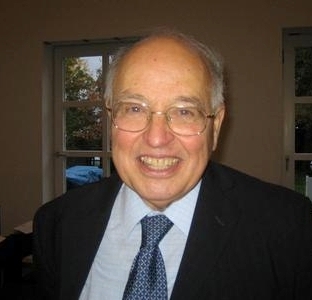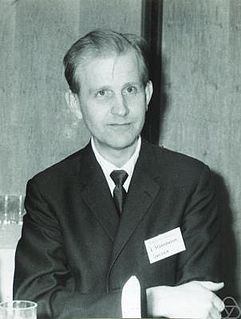
Sir Michael Francis Atiyah was a British-Lebanese mathematician specialising in geometry.
In mathematics, the uniformization theorem says that every simply connected Riemann surface is conformally equivalent to one of three Riemann surfaces: the open unit disk, the complex plane, or the Riemann sphere. In particular it implies that every Riemann surface admits a Riemannian metric of constant curvature. For compact Riemann surfaces, those with universal cover the unit disk are precisely the hyperbolic surfaces of genus greater than 1, all with non-abelian fundamental group; those with universal cover the complex plane are the Riemann surfaces of genus 1, namely the complex tori or elliptic curves with fundamental group Z2; and those with universal cover the Riemann sphere are those of genus zero, namely the Riemann sphere itself, with trivial fundamental group.
In differential geometry, the Atiyah–Singer index theorem, proved by Michael Atiyah and Isadore Singer (1963), states that for an elliptic differential operator on a compact manifold, the analytical index is equal to the topological index. It includes many other theorems, such as the Chern–Gauss–Bonnet theorem and Riemann–Roch theorem, as special cases, and has applications to theoretical physics.

Raoul Bott was a Hungarian-American mathematician known for numerous basic contributions to geometry in its broad sense. He is best known for his Bott periodicity theorem, the Morse–Bott functions which he used in this context, and the Borel–Bott–Weil theorem.

Lars Valter Hörmander was a Swedish mathematician who has been called "the foremost contributor to the modern theory of linear partial differential equations". Hörmander was awarded the Fields Medal in 1962 and the Wolf Prize in 1988. In 2006 he was awarded the Steele Prize for Mathematical Exposition for his four-volume textbook Analysis of Linear Partial Differential Operators, which is considered a foundational work on the subject.

In the theory of partial differential equations, elliptic operators are differential operators that generalize the Laplace operator. They are defined by the condition that the coefficients of the highest-order derivatives be positive, which implies the key property that the principal symbol is invertible, or equivalently that there are no real characteristic directions.

Marcel Riesz was a Hungarian mathematician, known for work on summation methods, potential theory, and other parts of analysis, as well as number theory, partial differential equations, and Clifford algebras. He spent most of his career in Lund (Sweden).
Hilbert's nineteenth problem is one of the 23 Hilbert problems, set out in a list compiled in 1900 by David Hilbert. It asks whether the solutions of regular problems in the calculus of variations are always analytic. Informally, and perhaps less directly, since Hilbert's concept of a "regular variational problem" identifies precisely a variational problem whose Euler–Lagrange equation is an elliptic partial differential equation with analytic coefficients, Hilbert's nineteenth problem, despite its seemingly technical statement, simply asks whether, in this class of partial differential equations, any solution function inherits the relatively simple and well understood structure from the solved equation. Hilbert's nineteenth problem was solved independently in the late 1950s by Ennio De Giorgi and John Forbes Nash, Jr.

Ivan Georgievich Petrovsky was a Soviet mathematician working mainly in the field of partial differential equations. He greatly contributed to the solution of Hilbert's 19th and 16th problems, and discovered what are now called Petrovsky lacunas. He also worked on the theories of boundary value problems, probability, and on the topology of algebraic curves and surfaces.

Torsten Carleman, born Tage Gillis Torsten Carleman, was a Swedish mathematician, known for his results in classical analysis and its applications. As the director of the Mittag-Leffler Institute for more than two decades, Carleman was the most influential mathematician in Sweden.
Lars Gårding was a Swedish mathematician. He made notable contributions to the study of partial differential equations and partial differential operators. He was a professor of mathematics at Lund University in Sweden 1952–1984. Together with Marcel Riesz, he was a thesis advisor for Lars Hörmander.
In mathematics, and specifically the field of partial differential equations (PDEs), a parametrix is an approximation to a fundamental solution of a PDE, and is essentially an approximate inverse to a differential operator.
In mathematics, the signature operator is an elliptic differential operator defined on a certain subspace of the space of differential forms on an even-dimensional compact Riemannian manifold, whose analytic index is the same as the topological signature of the manifold if the dimension of the manifold is a multiple of four. It is an instance of a Dirac-type operator.
In the theory of functions of several complex variables, Hartogs's extension theorem is a statement about the singularities of holomorphic functions of several variables. Informally, it states that the support of the singularities of such functions cannot be compact, therefore the singular set of a function of several complex variables must 'go off to infinity' in some direction. More precisely, it shows that an isolated singularity is always a removable singularity for any analytic function of n > 1 complex variables. A first version of this theorem was proved by Friedrich Hartogs, and as such it is known also as Hartogs's lemma and Hartogs's principle: in earlier Soviet literature, it is also called Osgood–Brown theorem, acknowledging later work by Arthur Barton Brown and William Fogg Osgood. This property of holomorphic functions of several variables is also called Hartogs's phenomenon: however, the locution "Hartogs's phenomenon" is also used to identify the property of solutions of systems of partial differential or convolution equations satisfying Hartogs type theorems.
Lesley Millman Sibner was an American mathematician and professor of mathematics at Polytechnic Institute of New York University. She earned her Bachelors at City College CUNY in Mathematics. She completed her doctorate at Courant Institute NYU in 1964 under the joint supervision of Lipman Bers and Cathleen Morawetz. Her thesis concerned partial differential equations of mixed-type.
In complex analysis of one and several complex variables, Wirtinger derivatives, named after Wilhelm Wirtinger who introduced them in 1927 in the course of his studies on the theory of functions of several complex variables, are partial differential operators of the first order which behave in a very similar manner to the ordinary derivatives with respect to one real variable, when applied to holomorphic functions, antiholomorphic functions or simply differentiable functions on complex domains. These operators permit the construction of a differential calculus for such functions that is entirely analogous to the ordinary differential calculus for functions of real variables.
Tatyana Olegovna Shaposhnikova is a Russian-born Swedish mathematician. She is best known for her work in the theory of multipliers in function spaces, partial differential operators and history of mathematics, some of which was partly done jointly with Vladimir Maz'ya. She is also a translator of both scientific and literary texts.

Aldo Andreotti was an Italian mathematician who worked on algebraic geometry, on the theory of functions of several complex variables and on partial differential operators. Notably he proved the Andreotti–Frankel theorem, the Andreotti–Grauert theorem, the Andreotti–Vesentini theorem and introduced, jointly with François Norguet, the Andreotti–Norguet integral representation for functions of several complex variables.
In mathematics, and especially differential geometry, the Quillen metric is a metric on the determinant line bundle of a family of operators. It was introduced by Daniel Quillen for certain elliptic operators over a Riemann surface, and generalized to higher-dimensional manifolds by Jean-Michel Bismut and Dan Freed.

Lars Håkan Eliasson is a Swedish mathematician.









